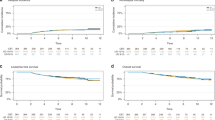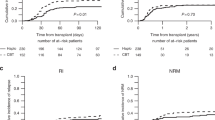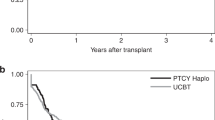Abstract
This study included data from 185 consecutively treated patients, 16 years of age or older, who underwent myeloablative transplantation using unrelated umbilical cord blood (UCB) (UCB transplantation (UCBT), n=70) or HLA-identical sibling donor peripheral blood stem cells alone or combined with bone marrow (BMT/PBSCT, n=115) from October 2001 to December 2012. All patients received myeloablative regimens, cyclosporin A plus mycophenolate mofetil as prophylaxis for GVHD, and similar supportive care. Although hematopoietic recovery was significantly delayed after UCBT, the rate of neutrophil engraftment was comparable. The median follow-up was 53 months (range, 15–136 months) for BMT/peripheral blood SCT (PBSCT) recipients and 35 months (range, 10–123 months) for UCBT recipients. There were no significant differences in the cumulative incidence of grades III to IV acute GVHD, relapse rate, or 3-year probabilities of disease-free survival between patients receiving UCBT and those receiving BMT/PBSCT. However, the cumulative incidence of chronic and extensive chronic GVHD was lower in UCBT recipients. The rates of long-term survivors returning to school or work and off immunosuppressive therapy were significantly higher after UCBT, which indicated that long-term survivors who underwent UCBT had a higher quality of life.
This is a preview of subscription content, access via your institution
Access options
Subscribe to this journal
Receive 12 print issues and online access
$259.00 per year
only $21.58 per issue
Buy this article
- Purchase on Springer Link
- Instant access to full article PDF
Prices may be subject to local taxes which are calculated during checkout



Similar content being viewed by others
References
Ottinger H, Grosse-Wilde M, Schmitz A, Grosse-Wilde H Immunogenetic marrow donor search for 1012 patients: a retrospective analysis of strategies, outcome and costs. Bone Marrow Transplant 1994; 14 (suppl 4): S34–S38.
Martin T, Sharma M, Damon L, Kaplan L, Guglielmo BJ, Working M et al. Voriconazole is safe and effective as prophylaxis for early and late fungal infections following allogeneic hematopoietic stem cell transplantation. Transpl Infect Dis 2010; 12: 45–50.
Lee SJ, Klein J, Haagenson M, Baxter-Lowe LA, Confer DL, Eapen M et al. High-resolution donor recipient HLA matching contributes to the success of unrelated donor marrow transplantation. Blood 2007; 110: 4576–4583.
Woolfrey A, Klein JP, Haagenson M, Spellman S, Petersdorf E, Oudshoorn M et al. HLA-C antigen mismatch is associated with worse outcome in unrelated donor peripheral blood stem cell transplantation. Biol Blood Marrow Transplant 2011; 17: 885–892.
Ciurea SO, Thall PF, Wang X, Wang SA, Hu Y, Cano P et al. Donor-specific anti-HLA Abs and graft failure in matched unrelated donor hematopoietic stem cell transplantation. Blood 2011; 118: 5957–5964.
Finke J, Bethge WA, Schmoor C, Ottinger HD, Stelljes M, Zander AR et al. Standard graft-versus-host disease prophylaxis with or without anti-T-cell globulin in haematopoietic cell transplantation from matched unrelated donors: a randomised, open-label, multicentre phase 3 trial. Lancet Oncol 2009; 10: 855–864.
Fuch EJ Human leukocyte antigen-haploidentical stem cell transplantation using T-cell-replete bone marrow grafts. Curr Opin Hematol 2012; 19: 440–447.
Brunstein CG, Fuchs EJ, Carter SL, Karanes C, Costa LJ, Wu J et al. Alternative donor transplantation after reduced intensity conditioning: results of parallel phase 2 trials using partially HLA-mismatched related bone marrow or unrelated double umbilical cord blood grafts. Blood 2011; 118: 282–288.
Mori T, Tanaka M, Kobayashi T, Ohashi K, Fujisawa S, Yokota A et al. Prospective multicenter study of single-unit cord blood transplantation with myeloablative conditioning for adult patients with high-risk hematologic malignancies. Biol Blood Marrow Transplant 2013; 19: 486–491.
Gooley TA, Chien JW, Pergam SA, Hingorani S, Sorror ML, Boeckh M et al. Reduced mortality after allogeneic hematopoietic-cell transplantation. New Engl J Med 2010; 363: 2091–2101.
Horan JT, Logan BR, Agovi-Johnson MA, Lazarus HM, Bacigalupo AA, Ballen KK et al. Reducing the risk for transplantation-related mortality after allogeneic hematopoietic cell transplantation: how much progress has been made? J Clin Oncol 2011; 29: 805–813.
Remberger M, Ackefors M, Berglund S, Blennow O, Dahllof G, Dlugosz A et al. Improved survival after allogeneic hematopoietic stem cell transplantation in recent years. A single-center study. Biol Blood Marrow Transplant 2011; 17: 1688–1697.
Saber W, Opie S, Rizzo JD, Zhang MJ, Horowitz MM, Schriber J . Outcomes after matched unrelated donor versus identical sibling hematopoietic cell transplantation in adults with acute myelogenous leukemia. Blood 2012; 119: 3908–3916.
Wang Y, Liu DH, Xu LP, Liu KY, Chen H, Chen YH et al. Superior graft-versus-leukemia effect associated with transplantation of haploidentical compared with HLA-identical sibling donor grafts for high-risk acute leukemia: an historic comparison. Biol Blood Marrow Transplant 2011; 17: 821–830.
Gutman JA, Leisenring W, Appelbaum FR, Woolfrey AE, Delaney C, Delaney C Low relapse without excessive transplant-related mortality following myeloablative cord blood transplantation for acute leukemia in complete remission: a matched cohort analysis. Biol Blood Marrow Transplant 2009; 15: 1122–1129.
Takahashi S, Ooi J, Tomonari A, Konuma T, Tsukada N, Oiwa-Monna M et al. Comparative single-institute analysis of cord blood transplantation from unrelated donors with bone marrow or peripheral blood stem-cell transplants from related donors in adult patients with hematologic malignancies after myeloablative conditioning regimen. Blood 2007; 109: 1322–1330.
Barker JN, Scaradavou A, Stevens CE Combined effect of total nucleated cell dose and HLA match on transplantation outcome in 1061 cord blood recipients with hematological malignancies. Blood 2010; 115: 1843–1849.
Eapen M, Klein JP, Sanz GF, Spellman S, Ruggeri A, Anasetti C et al. Effect of donor-recipient HLA matching at HLAA, B, C, and DRB1 on outcomes after umbilical-cord blood transplantation for leukaemia and myelodysplastic syndrome: a retrospective analysis. Lancet Oncol 2011; 12: 1214–1221.
Ponce DM, Sauter C, Devlin S, Lubin M, Gonzales AM, Kernan NA et al. A novel reduced-intensity conditioning regimen induces a high incidence of sustained donor-derived neutrophil and platelet engraftment after double-unit cord blood transplantation. Biol Blood Marrow Transplant 2013; 19: 799–803.
Yoshihara S, Ikegame K, Taniguchi K, Kaida K, Kim EH, Nakata J et al. Salvage haploidentical transplantation for graft failure using reduced-intensity conditioning. Bone Marrow Transplant 2012; 47: 369–373.
Fuji S, Nakamura F, Hatanaka K, Taniguchi S, Sato M, Mori S et al. Peripheral blood as a preferable source of stem cells for salvage transplantation in patients with graft failure after cord blood transplantation: a retrospective analysis of the registry data of the Japanese Society for Hematopoietic Cell Transplantation. Biol Blood Marrow Transplant 2012; 18: 1407–1414.
Kanda J, Horwitz ME, Long GD, Gasparetto C, Sullivan KM, Chute JP et al. Outcomes of a 1-day nonmyeloablative salvage regimen for patients with primary graft failure after allogeneic hematopoietic cell transplantation. Bone Marrow Transplant 2012; 47: 700–705.
Liu HL, Sun ZM, Geng LQ, Wang XB, Ding KY, Tang BI et al. Unrelated cord blood transplantation for newly diagnosed patients with severe acquired aplastic anemia using a reduced intensity conditioning: high graft rejection, but good survival. Bone Marrow Transplantation 2012; 47: 1186–1190.
Park M, Lee SH, Lee YH, Yoo KH, Sung KW, Koo HH et al. Pre-engraftment syndrome after unrelated cord blood transplantation: a predictor of engraftment and acute graft-versus-host disease. Biol Blood Marrow Transplant 2013; 19: 640–646.
Przepiorka D, Weisdorf D, Martin P, Klingemann HG, Beatty P, Hows J et al. 1994 Consensus conference on acute GVHD grading. Bone Marrow Transplant 1995; 15: 825–828.
Filipovich AH, Weisdorf D, Pavletic S, Socie G, Wingard JR, Lee SJ et al. National Institutes of Health consensus development project on criteria for clinical trials in chronic graft-versus-host disease: I. Diagnosis and staging working group report. Biol Blood Marrow Transplant 2005; 11: 945–956.
Rocha V, Labopin M, Sanz G, Arcese W, Schwerdtfeger R, Bosi A et al. Transplants of umbilical-cord blood or bone marrow from unrelated donors in adults with acute leukemia. Acute Leukemia Working Party of European Blood and Marrow Transplant Group; Eurocord-Netcord Registry. New Engl J Med 2004; 351: 2276–2285.
Cornetta K, Laughlin M, Carter S, Wall D, Weinthal J, Delaney C et al. Umbilical cord blood transplantation in adults: results of the prospective Cord Blood Transplantation (COBLT). Biol Blood Marrow Transplant 2005; 11: 149–160.
Ponce DM, Gonzales A, Lubin M, Castro-Malaspina H, Giralt S, Goldberg JD et al. Graft-versus-host disease after double-unit cord blood transplantation has unique features and an association with engrafting unit-to-recipient HLA match. Biol Blood Marrow Transplant 2013; 19: 904–911.
Kanda Y, Sakamaki H, Sao H, Okamoto S, Kodera Y, Tanosaki R et al. Effect of conditioning regimen on the outcome of bone marrow transplantation from an unrelated donor. Biol Blood Marrow Transplant 2005; 11: 881–889.
Lindemans CA, Chiesa R, Amrolia PJ, Rao K, Nikolajeva O, de Wildt A et al. Impact of thymoglobulin prior to pediatric unrelated umbilical cord blood transplantation on immune reconstitution and clinical outcome. Blood 2014; 123: 126–132.
Narimatsu H, Miyakoshi S, Yamaguchi T, Kami M, Matsumura T, Yuji K et al. Chronic graft-versus-host disease following umbilical cord blood transplantation: retrospective survey involving 1072 patients in Japan. Blood 2008; 112: 2579–2582.
Baker KS, Gurney JG, Ness KK, Bhatia R, Forman SJ, Francisco L et al. Late effects in survivors of chronic myeloid leukemia treated with hematopoietic cell transplantation: results from the Bone Marrow Transplant Survivor Study. Blood 2004; 104: 1898–1906.
Wong FL, Francisco L, Togawa K, Bosworth A, Gonzales M, Hanby C et al. Long-term recovery after hematopoietic cell transplantation: predictors of quality-of-life concerns. Blood 2010; 115: 2508–2519.
Pidala J, Kurland B, Chai X, Majhail N, Weisdorf DJ, Pavletic S et al. Patient-reported quality of life is associated with severity of chronic graft-versus-host disease as measured by NIH criteria: report on baseline data from the Chronic GVHD Consortium. report on baseline data from the Chronic GVHD Consortium. Blood 2011; 117: 4651–4657.
Sun CL, Francisco L, Baker KS, Weisdorf DJ, Forman SJ, Bhatia S Adverse psychological outcomes in long-term survivors of hematopoietic cell transplantation: a report from the Bone Marrow Transplant Survivor Study (BMTSS). Blood 2011; 118: 4723–4731.
Acknowledgements
This work was supported by the National Natural Science Foundation (81250001), the Anhui Provincial Scientific and Technological Projects Foundation (11010402164) and the Anhui Provincial ‘115’ Industrial Innovation Program (2009).
Author information
Authors and Affiliations
Corresponding author
Ethics declarations
Competing interests
The authors declare no conflict of interest.
Rights and permissions
About this article
Cite this article
Liu, Hl., Sun, Zm., Geng, Lq. et al. Similar survival, but better quality of life after myeloablative transplantation using unrelated cord blood vs matched sibling donors in adults with hematologic malignancies. Bone Marrow Transplant 49, 1063–1069 (2014). https://doi.org/10.1038/bmt.2014.102
Received:
Revised:
Accepted:
Published:
Issue Date:
DOI: https://doi.org/10.1038/bmt.2014.102
This article is cited by
-
Should a matched sibling donor still be considered the primary option for allogeneic hematopoietic cell transplantation in patients over 50 years of age with myelodysplastic syndrome?
Bone Marrow Transplantation (2023)
-
Comparing cord blood transplantation and matched related donor transplantation in non-remission acute myeloid leukemia
Leukemia (2022)
-
Quality of life following cord blood versus matched sibling donor transplantation: pre-transplantation psychiatric and socioeconomic factors significantly impact outcomes
Bone Marrow Transplantation (2022)
-
Impact of donor type on long-term graft-versus-host disease-free/relapse-free survival for adult acute lymphoblastic leukemia in first remission
Bone Marrow Transplantation (2021)
-
Clinical separation of cGvHD and GvL and better GvHD-free/relapse-free survival (GRFS) after unrelated cord blood transplantation for AML
Bone Marrow Transplantation (2017)



